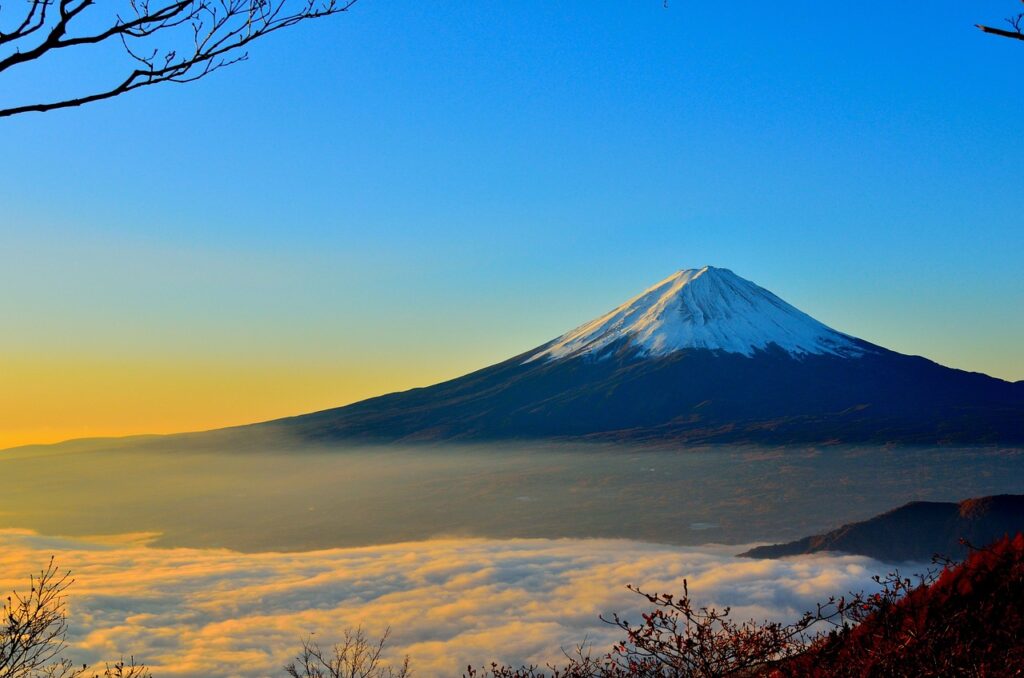Photographing Mount Fuji, Japan’s iconic volcano, requires careful planning and attention to detail. Here are some tips to help you capture stunning images of this majestic mountain:
- Timing is Everything:
- Visit during the fall (late September to early December) for vibrant autumn colors or in spring (late March to early May) for cherry blossoms. Early morning or sunset shots often yield the best lighting.
- Location, Location, Location:
- Choose your shooting location wisely. Popular spots include Lake Kawaguchi, Chureito Pagoda, and the northern shores of Lake Saiko. Research and scout locations beforehand for the best angles.
- Weather Considerations:
- Keep an eye on the weather forecast. Clear, crisp days offer the best visibility, but mist or fog can create a unique, moody atmosphere.
- Wide Angle Lenses:
- Use a wide-angle lens (around 16-35mm) to capture the vastness of the landscape. This allows you to include foreground elements and the mountain in a single frame.
- Foreground Interest:
- Incorporate interesting foreground elements like trees, rocks, or buildings to add depth and perspective to your shot.
- Golden Hours:
- Shoot during the golden hours—shortly after sunrise and just before sunset. The warm, soft light enhances the colors and textures in the scene.
- Long Exposures:
- Consider using long exposure techniques, especially if there is water in the foreground. This can create a smooth, ethereal effect.
- Use a Tripod:
- A sturdy tripod is essential for long exposures and ensuring sharp, stable shots.
- Bracketing for HDR:
- Use bracketing to capture a wider range of tones, especially during sunrise or sunset. This will help retain details in both shadows and highlights.
- Filters:
- Use a polarizing filter to reduce glare and enhance colors, especially in shots with water or a blue sky. Graduated neutral density filters can also help balance exposure between the sky and the foreground.
- Experiment with Different Perspectives:
- Don’t just shoot from eye level. Try different angles and heights to add variety and interest to your shots.
- Silhouettes and Shadows:
- Experiment with capturing Mount Fuji as a silhouette against colorful skies, or use shadows to add a sense of drama.
- Framing:
- Look for natural frames like arches, trees, or buildings to add interest and draw the viewer’s eye towards Mount Fuji.
- Post-Processing:
- Use photo editing software to fine-tune your images. Adjust exposure, contrast, white balance, and apply sharpening if needed.
- Respect Local Regulations:
- Be aware of any photography restrictions or rules in the area, especially if you’re using professional equipment or planning to shoot at sensitive locations.
Remember, patience and persistence are key. Weather conditions can change rapidly around Mount Fuji, so be prepared to wait for that perfect shot. With these tips in mind, you’ll be well-equipped to capture the beauty and majesty of this iconic mountain. Happy shooting!
- What is Midjourney
 Discover the capabilities of Midjourney AI, learn how to effectively utilize the platform, and explore the advantages and disadvantages of the Midjourney AI image generator across its different pricing options.
Discover the capabilities of Midjourney AI, learn how to effectively utilize the platform, and explore the advantages and disadvantages of the Midjourney AI image generator across its different pricing options. - Brand identity elements
 In the vast marketing universe, imagery is pivotal in establishing and nurturing a brand’s identity. A brand’s visual choices are not merely aesthetic decisions but strategic moves that can significantly influence perception and performance. This Picfixs article explores the intricacies of selecting imagery that complements and enhances a brand’s essence, ensuring it resonates with the… Read more: Brand identity elements
In the vast marketing universe, imagery is pivotal in establishing and nurturing a brand’s identity. A brand’s visual choices are not merely aesthetic decisions but strategic moves that can significantly influence perception and performance. This Picfixs article explores the intricacies of selecting imagery that complements and enhances a brand’s essence, ensuring it resonates with the… Read more: Brand identity elements - 100 Best Mountain Captions and Mountain Quotes for Instagram
 Ready to scale new social media heights? Look no further than this treasure trove of 100 exhilarating captions and quotes, handpicked for your Instagram mountain posts!
Ready to scale new social media heights? Look no further than this treasure trove of 100 exhilarating captions and quotes, handpicked for your Instagram mountain posts! - Symmetry in Photography: A Creative Approach with Examples
 Delve into the enchanting realm of symmetry in photography as we showcase mesmerizing examples on our website. Experience the allure of perfectly mirrored images!
Delve into the enchanting realm of symmetry in photography as we showcase mesmerizing examples on our website. Experience the allure of perfectly mirrored images! - 11 Quarantine Photoshoot Ideas to Try at Home for Amazing Photos
 Looking for unique photoshoot ideas during quarantine? Explore the 11 creative suggestions that will help you capture unforgettable moments at home.
Looking for unique photoshoot ideas during quarantine? Explore the 11 creative suggestions that will help you capture unforgettable moments at home.


